The 10 Days Annapurna Base Camp Trekking experience captivates adventurers with its diverse landscapes and rich cultural encounters. Starting from the bustling streets of Kathmandu, trekkers embark on a journey that leads them through picturesque villages and terraced fields, all while being surrounded by towering peaks. The itinerary is designed to accommodate various fitness levels, ensuring that both solo travelers and groups can enjoy this remarkable trek. But what about the essential preparations and the best times to undertake this adventure? The answers might just transform the way one approaches this iconic journey.
Good To Know
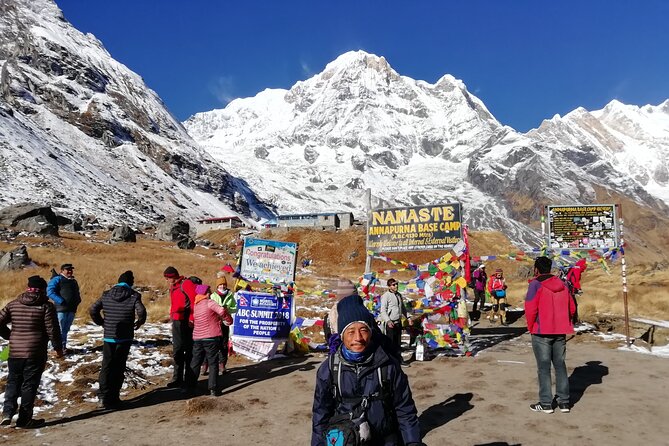
- The Annapurna Base Camp Trek typically spans 5 days, but can be extended to 10 days for a more leisurely experience.
- Trekkers enjoy breathtaking views of the Annapurna massif and cultural interactions with local villagers throughout the journey.
- The best seasons for trekking are spring (March to May) and autumn (September to November) for optimal weather conditions.
- Essential inclusions in the package cover airport transfers, accommodations, meals during the trek, and scenic flights.
- Proper physical fitness is important, requiring regular hiking and cardiovascular exercises before the trek to ensure readiness.
Trek Overview and Highlights

When adventurers embark on the Annapurna Base Camp Trek, they’re stepping into one of the most celebrated trekking routes in the world.
This trek showcases breathtaking views of majestic mountains, including the iconic Mount Annapurna, which towers at 8,091 meters. Reaching Annapurna Base Camp at 4,130 meters offers trekkers a unique opportunity to witness the spectacular Annapurna massif up close.
Along the way, they’ll traverse through charming Nepali villages, seeing local culture and traditional lifestyles. The scenic trails lead to stunning vistas, with highlights such as the Fishtail Mountain (Machapuchhre).
This trek is designed for all adventurers, whether they’re solo travelers or groups, making it accessible and memorable for everyone who dares to explore.
You can also read our reviews of more tours and experiences in Kathmandu.
Detailed Itinerary
With the breathtaking scenery and cultural experiences set before them, trekkers can look forward to an exciting itinerary that guides them through the Annapurna region. Each day offers a unique adventure, from lush valleys to towering peaks. Here’s a snapshot of the itinerary:
| Day | Activity |
|---|---|
| 1 | Arrival in Kathmandu |
| 2 | Fly to Pokhara, trek to Ghandruk |
| 3 | Trek from Ghandruk to Chhomrong |
| 4 | Trek to Deurali |
| 5 | Reach Annapurna Base Camp |
| 6 | Return trek to Bamboo |
| 7 | Trek to Jhinu Danda |
| 8 | Trek to Nayapul, drive to Pokhara |
| 9 | Flight back to Kathmandu |
| 10 | Departure from Kathmandu |
This carefully planned itinerary ensures trekkers experience the best of the Annapurna region.
Essential Inclusions
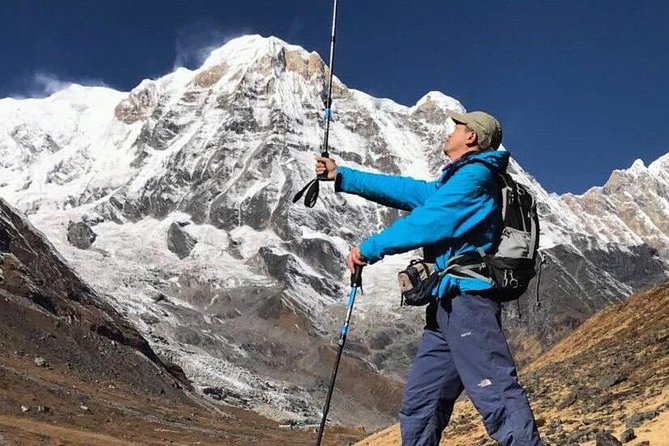
For those embarking on the Annapurna Base Camp Trek, understanding the essential inclusions is crucial for a seamless experience. The package typically covers airport pickup and drop services, ensuring a smooth arrival and departure.
Trekking participants enjoy accommodations in three-star hotels in Kathmandu and Pokhara, complete with breakfast, alongside teahouse or lodge stays during the trek, which include all meals. Plus, the itinerary features scenic flights and drives, enhancing the overall experience.
While the package provides valuable services, travelers should note that international airfare, travel insurance, and meals in Kathmandu and Pokhara aren’t included. This clarity helps trekkers prepare adequately, making their adventure more enjoyable and hassle-free.
Physical Fitness Requirements
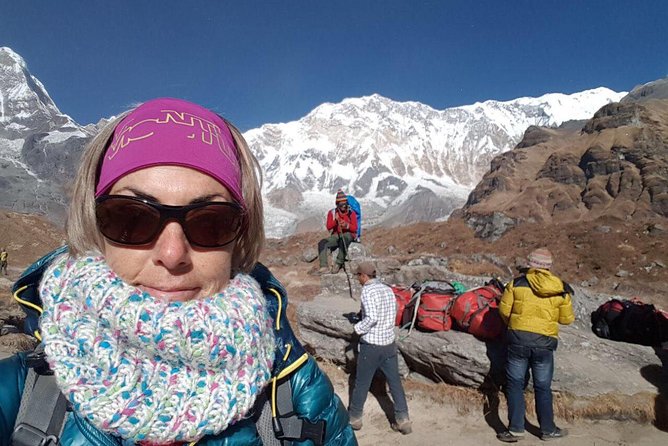
Trekking to Annapurna Base Camp demands a moderate level of physical fitness, making it accessible to many adventurers. While prior trekking experience isn’t essential, participants should prepare for varied terrain with steep ascents and descents. To help gauge readiness, consider the following fitness guidelines:
| Activity | Recommended Duration |
|---|---|
| Hiking on uneven terrain | 2-3 hours, 2-3 times weekly |
| Cardiovascular exercise | 30 minutes, 3-4 times weekly |
| Strength training | 30 minutes, 2-3 times weekly |
| Flexibility exercises | 15 minutes, daily |
| Rest and recovery | 1-2 days between workouts |
Accessibility Information

Ensuring a smooth trekking experience to Annapurna Base Camp involves understanding accessibility factors. The trek isn’t wheelchair accessible, making it essential for participants to have a moderate fitness level.
Trekkers should prepare for varied terrain, including steep ascents and descents, particularly on the days leading to and from the base camp. The trail can be challenging, so proper footwear and trekking poles are recommended for stability.
Plus, accommodations along the route vary from comfortable teahouses to basic lodges, which may not always have modern amenities. Travelers should be ready for basic conditions and pack accordingly.
Customer Experiences
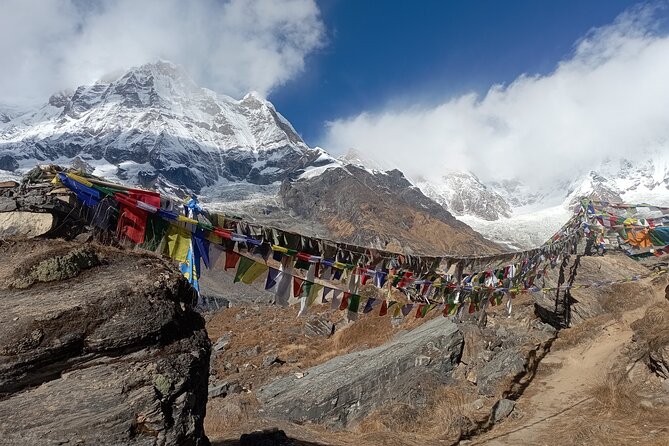
Customer experiences on the Annapurna Base Camp trek highlight a blend of breathtaking natural beauty and rich cultural interactions.
Travelers often rave about the stunning views of the majestic Annapurna range, particularly the iconic Machapuchhre. Many appreciate the opportunity to connect with local villagers, seeing the vibrant culture and traditions of the region.
Reviews frequently commend the professionalism and warmth of the trekking guides, who ensure a smooth and enjoyable journey. Customers also mention the comfortable teahouse accommodations and delicious local meals that enhance their trekking experience.
Best Time to Trek
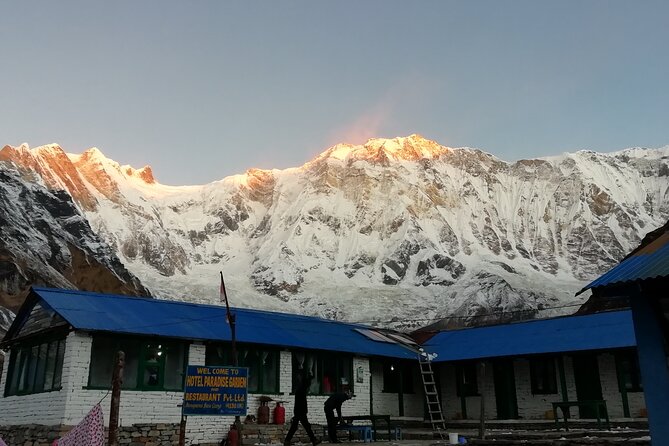
The ideal time to embark on the Annapurna Base Camp trek is during the spring (March to May) and autumn (September to November) seasons.
During these months, trekkers can enjoy clear skies, moderate temperatures, and stunning mountain views. Spring showcases blooming rhododendrons, adding vibrant colors to the landscape, while autumn offers crisp air and stable weather conditions.
In contrast, the summer monsoon (June to August) brings heavy rains, making trails slippery and potentially dangerous.
Winter (December to February) poses its own challenges, with cold temperatures and snow accumulation at higher altitudes.
Therefore, planning the trek during spring or autumn ensures a more enjoyable experience, allowing trekkers to fully appreciate the breathtaking beauty of the Annapurna region.
Packing List Essentials
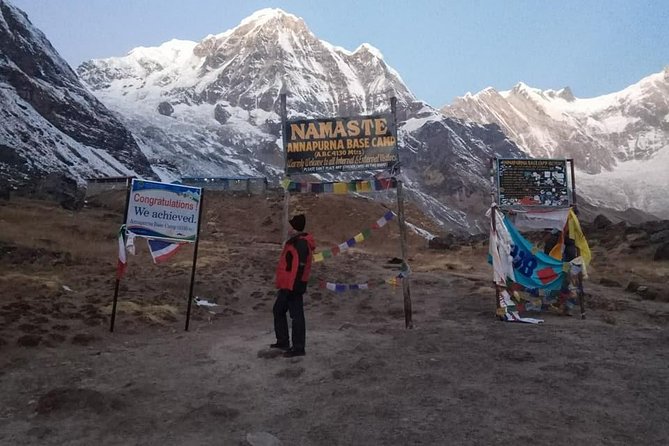
Planning for the Annapurna Base Camp trek involves careful consideration of what to pack. Essential items include a sturdy backpack, waterproof trekking boots, and layered clothing for fluctuating temperatures.
A down jacket and a waterproof shell are crucial for keeping warm and dry. Don’t forget a sleeping bag rated for cold weather, as nights can be chilly at higher altitudes.
Bring a reusable water bottle and purification tablets to stay hydrated. Trekking poles can provide stability on uneven terrain, while a first-aid kit should include basic supplies.
Lastly, pack sunscreen and lip balm to protect from the high-altitude sun. With these essentials, trekkers will be well-prepared for a memorable adventure in the stunning Annapurna region.
Frequently Asked Questions
What Is the Best Way to Prepare for High Altitude Trekking?
To prepare for high altitude trekking, one should build cardiovascular fitness, acclimatize gradually, stay hydrated, and practice strength training. Proper gear and nutrition also enhance stamina, ensuring a safer, more enjoyable trekking experience.
Are There Any Age Restrictions for the Annapurna Base Camp Trek?
There aren’t strict age restrictions for the trek, but participants should be in good physical condition. Many trekkers between 12 and 60 succeed, while younger or older adventurers can join if they’re adequately prepared.
Is Wi-Fi Available During the Trek?
Wi-Fi’s limited during the trek, but some teahouses offer it for a fee. Travelers should prepare for intermittent connectivity, enjoying the natural surroundings instead of relying heavily on their devices for updates.
Can I Hire a Guide or Porter on the Trek?
Yes, trekkers can hire guides or porters during the trek. These professionals enhance the experience, offering local insights and assistance with gear, ensuring a smoother journey through the stunning landscapes and challenging terrains.
What Should I Do in Case of an Emergency During the Trek?
In case of an emergency during the trek, he should remain calm, assess the situation, and seek help from fellow trekkers or guides. Contacting local authorities or medical services can also ensure prompt assistance.
The Sum Up
To sum it up, the 10 Days Annapurna Base Camp Trekking adventure promises an exhilarating journey through breathtaking landscapes and vibrant cultures. With a well-structured itinerary and essential inclusions, trekkers of all levels can find joy in this unforgettable experience. Whether it’s the stunning mountain views or the warmth of the local hospitality, this trek offers something truly special. So, lace up your boots, pack wisely, and get ready for an adventure that’ll leave lasting memories.
More Hiking & Trekking Tours in Kathmandu
More Tour Reviews in Kathmandu
Not for you? Here's more nearby things to do in Kathmandu we have reviewed
- From Lukla: Everest Base Camp (EBC) 10-Day Trek
- Kathmandu : Everest Mountain Flight – with Private Transfers
- Full Day : Kathmandu Sightseeing By Bus Day Trip
- Kathmandu: 7 UNESCO World Heritage Sites Day Tour
- Kathmandu: 8-Day Langtang Valley Trek with Transfers
- Thamel Rickshaw Tour
- Everest View Motorbike Tour- 6 Days
- Kathmandu: Top 4 UNESCO Sites Private/Group Tour with Lunch
- From Oceans to Mountains-9 Days (Nepal Guided Tour)
- From Kathmandu: Everest Base Camp Helicopter Tour landings
- Kathmandu: Food and Drink Walking Tour
- Life and spirituality tour of Kathmandu
